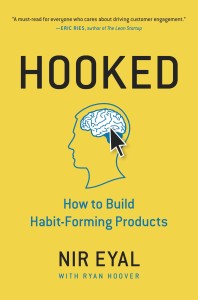 Nir Eyal’s Hooked: How to Build Habit Forming Products is perhaps one of the best books on User Experience and how to design for it available today. Not only does it cast light on the reasons that designers can use these mechanisms to influence action, it’s a handbook for how to develop these products, with an ethics-centered point of view that doesn’t proselytize. Anyway, accolades aside, what lessons can we take away from this book?
Nir Eyal’s Hooked: How to Build Habit Forming Products is perhaps one of the best books on User Experience and how to design for it available today. Not only does it cast light on the reasons that designers can use these mechanisms to influence action, it’s a handbook for how to develop these products, with an ethics-centered point of view that doesn’t proselytize. Anyway, accolades aside, what lessons can we take away from this book?
Variable Rewards
Before I had picked up this book, I found myself studying how User Experience design and Game design overlap. I was playing this game Crossy Road on my tablet, and found myself hooked. At the non-insightful level, I would have said “the gameplay was simple and addictive.” The barrier to beginning a new level is incredibly low; advertisement/monetization was brought in through a rather unique mechanism. You watch ads to get coins, which allow you to buy new characters. I saw that as being incredibly valuable, as it seemed to ensure that if you played an ad, you’ve taken the action, and therefore are more likely to watch it. You form an identity of yourself as someone who watches ads for fake currency. Or in my case, you play and play, gathering a dearth of coins spread out upon the course, or you wait for your six-hour bonus.
Yes, every six hours of real-world time, you would get a “free gift” from the game. You would get a seemingly random amount of in-game currency. Sometimes you’d get 90 coins— not enough to get a new character; other times you might get 450— more than enough for four characters. I found myself looking forward to this. Or as Nir Eyal says, “variable reward systems must satisfy users’ needs, while leaving them wanting to re-engage.” (page 94)
As designers become more adept at utilizing techniques of “hooking” users, we may see more games which provide a better in-game user experience (hey! look at how few ads there are!) while working the long con in terms of creating habitual, long term users.
Crossy Road was tapping into a need for novelty and variability (page 94), rewards of the hunt (page 79), wherein I felt the need to “catch them all” (a couple can only be obtained via purchase), and I was driven to beat my high score, the reward of the self (page 81). As I stepped back and looked at what this game was doing, it was a incredibly sophisticated bundle of techniques designed to hook a user.
I could satisfy these compulsions, once instilled in me, through purchase, providing an effective monetization scheme. It certainly seemed that some of the techniques were outwardly borrowed from the world of video gambling (page 80).
However, you may be saying that this seems kind of obvious. Yes, many Zynga games pioneered this same technique (page 92); however, what I found most interesting was how conspicuously buried the monetization elements were. It’s possible to have a nearly entirely ad-free experience. Cross Road’s pitch isn’t one of making money, as much as it is about systematically creating habits which money can substitute for. It’s more sophisticated in its subtlety than other games. As designers become more adept at utilizing techniques of “hooking” users, we may see more games which provide a better in-game user experience (hey! look at how few ads there are!) while working the long con in terms of creating habitual, long term users.
Hooking with Ethics
And that’s why I really like the model that is posited for helping designers, creators, and visionaries to see the impact of using the model. How do you know when you’re getting someone hooked if you’re operating in good or bad faith?

“With Great power comes great responsibility.” Is Crossy Road materially improving my life? Not quite. So are the designers my Entertainer or my Dealer?
I suppose the point isn’t to judge the makers of Crossy Road. I don’t buy characters, and I don’t even click the ads. I’ll take what they give me for free, so I think in terms of how it affects my life, it’s guilt free.
But as the maker, we shouldn’t necessarily be judged by our own, as much as we wish for others. I think this model, while not necessarily the be-all end-all, offers us a shorthand framework for gauging the ethical considerations of using these methodologies in our product.
